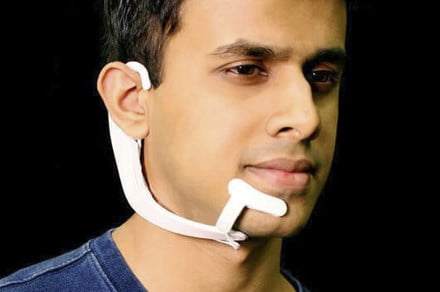Arnav Kapur/MIT
Imagine if you had a version of Amazon’s Alexa or Google Assistant inside your head, capable of feeding you external information whenever you required it, without you needing to say a single word and without anyone else hearing what it had to say back to you. An advanced version of this idea is the basis for future tech-utopian dreams like Elon Musk’s Neuralink, a kind of connected digital layer above the cortex that will let our brains tap into hitherto unimaginable machine intelligence.
Arnav Kapur, a postdoctoral student with the MIT Media Lab, has a similar idea. And he’s already shown it off.
The current AlterEgo device prototype looks a bit like one of those popstar Britney mics, as imagined by the designers of the Star Trek: The Next Generation TV show. It’s not exactly inconspicuous, but it also doesn’t look significantly different from the kind of hands-free kits that people too busy to physically hold their phones have been using for years. But it’s what it does that makes it really exciting.
[youtube https://www.youtube.com/watch?v=RuUSc53Xpeg?feature=oembed&w=100&h=100]
AlterEgo is, for all intents and purposes, the closest thing we’ve got to detailed mind-reading technology. No, it doesn’t actually read the electrical signals from your brain, but it does let you silently ask questions, and then either have the answer fed back to your via bone-conduction technology. For a person with a speech impediment, it could also be used to dictate words for a computer to read out.
“Throughout the history of personal computing, computers have always been external systems or entities that we interact with: desktops, smartphones, artificial intelligence tools, and even robots,” Kapur told Digital Trends. “Could we flip this paradigm? Could we augment and extend human abilities and weave the powers of computing and machine intelligence as an intrinsic human cognitive ability.”
Augmenting abilities
Picture, for instance, wondering what the weather is like in Cape Town, South Africa. Like a surreptitious Siri, AlterEgo could look up this information and let you know the answer in an audio form that only you can hear. Or how about relaying information to your smart home devices to switch your lights on and off, or to start up your coffee machine from another room? Or how about traveling to a foreign country, internally vocalizing a phrase and having it translated into another language to enable multilingual conversation? Or doing complex sums in your head and instantly “knowing” the answer.
Arnav Kapur/MIT
The applications become more profound when considering how such a device could be used for a person with a neurodegenerative disease like Alzheimer’s. It could be possible to internally record semantic information and access this at a later time. (To be honest, many of us would probably benefit from this!). Or to offer unspoken cues in the form of memory aids. The dictation element would additionally prove a game-changer for people with speech disabilities caused by conditions ranging from strokes, brain injuries and tumors to Parkinson’s disease, ALS, Huntington’s disease, cerebral palsy, and more.
“My goal with AlterEgo is to enable people with speech pathologies to communicate in real time, the rates at which I speak,” Kapur said. “My current work with the system is working with a variety of patients and optimizing and engineering the system to enable communication.” According to him, the total number of people in the U.S. who fall into this category number around 7.5 million, roughly equivalent to the entire state of Washington.
So how does this potentially revolutionary technology work? “There are over 100 muscles involved in speech,” Kapur explained. “Now imagine only using a small fraction of those, and talking to yourself internally without producing any sound, without moving your lips, jaw or facial muscles. The system captures subtle neurological activation of the internal speech systems from the surface of the skin, even though the signal source is inside.”
[youtube https://www.youtube.com/watch?v=38qHDi45gT4?feature=oembed&w=100&h=100]
Kapur refers to the principle of electrical communication as “the currency of the human body.” When a person picks up a glass of water, moves their eyes, or types a brilliant article for Digital Trends, this involves an electrical signal traveling through the nerves to instruct a specific muscle to activate in a certain way in order to complete the action.
The power of inner speech
“You could think of internal speech system as really small batteries and what we do is measure change in the voltage,” he continued. “By carefully measuring the change in electrical field, you could sense activation of the neuromuscular unit — this is then translated into speech. The A.I. is trained on recognizing these signals and then makes sense of those commands. [Finally, it] sends an audio response through audio conducted through the skull into the user’s inner ear so as to not disrupt the user’s natural hearing of the world.”
The AlterEgo device is not yet available commercially, although for his work on it Kapur has picked up a $15,000 Lemelson-MIT Student Prize. Should this device make it to market, and live up to its potential, we imagine plenty more of both of those — prizes and cash — will follow.
“Our priority is to develop a non-invasive and non-intrusive system that does not render ethics as an afterthought,” Kapur said. “We are currently refining the technology and working on deployment with full steam.”
Before too long, hopefully you’ll be able to whip out your wallet and buy one. You know you want to: the little voice in your head, inaudible to everyone else, told you to.
Editors’ Recommendations
-
https://www.digitaltrends.com/wearables/facebook-is-making-progress-with-its-plan-to-let-you-type-with-your-mind/
-
https://www.digitaltrends.com/health-fitness/best-sleep-gadgets/
-
https://www.digitaltrends.com/cool-tech/weird-world-of-cyborg-botany/
-
https://www.digitaltrends.com/home-theater/wisa-wireless-explained/
-
https://www.digitaltrends.com/mobile/how-to-protect-your-smartphone-from-hackers-and-intruders/

